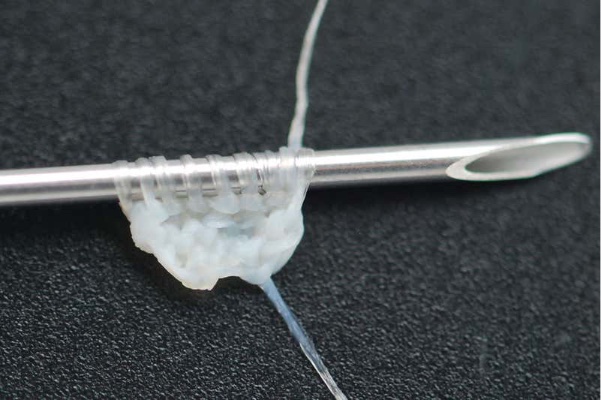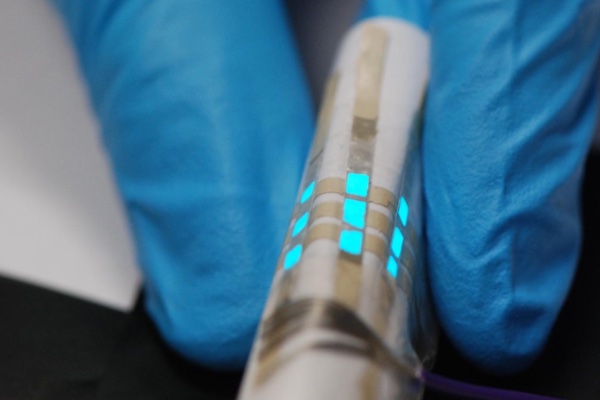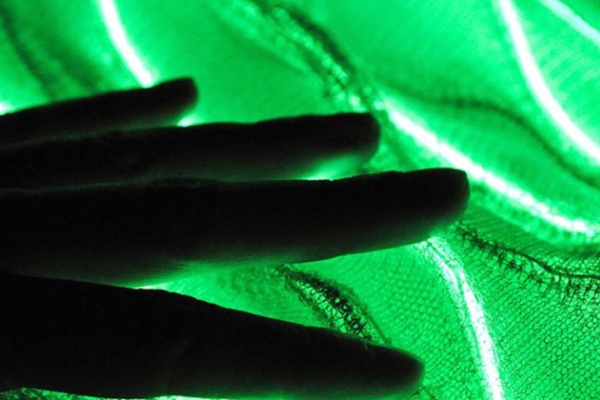ANTONIO LÓPEZ | Tungsteno
The combination of nanotechnology, electronics, artificial intelligence and new materials opens up a new horizon for fabrics and clothing. We are moving into the age of smart textiles, capable of interacting with people and the environment. Beyond regulating body temperature, their applications now make it possible to detect alterations in heart rhythm and even replicate the composition of human skin in order to "knit" wounds and promote their healing.
The basic mechanism behind these textiles is based on the use of sensors that can measure everything from temperature, humidity or blood pressure to the level of glucose in the blood. To achieve these functionalities, researchers at the Massachusetts Institute of Technology began incorporating microprocessors to transform these data into electrical signals in the mid-1990s. Since then, the miniaturisation of electronics, new fibres made from conductive materials and the development of wireless communication have fostered the emergence of health applications based on the use of smart textiles, a powerful tool in the prevention and treatment of various chronic diseases.
When, in addition, technologies such as electronics are combined with these smart fibres, on a scale smaller than the size of a grain of rice, the implications can be far-reaching for our daily lives. This is what happens when nanotechnology is applied, which makes it possible to compress matter to tiny (nanometric) sizes. The result is textile material that can function passively (like a thermochromic fabric that changes colour depending on temperature) or that can interact with the user and transmit data to a smartphone.

Being 100% biocompatible, the new "human textile" obtained from cells allows the creation of any type of tissue or valve, avoiding negative immune responses. Credit: Acta Biomateralia.
Silver fibres, UV light and ozone against COVID-19
Spurred on by the COVID-19 health crisis, the need to seek innovative solutions to prevent contagion has also become apparent in smart textiles. In the fight against the pandemic, a group of researchers from the Federal University of São Carlos has developed a fabric with silver and silica nanoparticles that has the capacity to eliminate the virus in minutes with an efficiency of 99.9%. Two other products have recently been designed with the same goal: Antiviraltex, which eliminates viruses such as influenza and coronaviruses, and Aircleantex, a fabric that is self-disinfecting thanks to a mechanism that transforms ultraviolet light into ozone. These offerings are particularly useful as they make it easier to clean curtains or blinds in nursing homes and hospitals, for example, which are more difficult to keep disinfected than other surfaces.
Yarn from human skin to close wounds
As well as protecting us from potential infection, smart textiles could also help us heal wounds and even facilitate transplants and grafts, thanks to a yarn of human skin cells that a group of researchers at the French National Institute for Medical and Health Research in Bordeaux has called "human textile." In research published in the journal Acta Biomaterialia, the authors explain how they have cut sheets of skin cells into long strips and then converted them into yarn, thereby creating a 100% biocompatible material that could be used to make any type of tissue or valve. These biological fibres would therefore be free from the risk of producing negative immune responses that complicate the healing process, and would thus be the ideal alternative to today's hypoallergenic synthetic materials.

Nanotechnology, artificial intelligence and new materials such as graphene advance the new revolution of smart fabrics. Credit: University of Exeter.
A textile that administers drugs
Another health-related application of textiles, and one closely linked to the monitoring potential of smart fibres, is that of administering drugs through the skin. This is the approach taken by a team of scientists from the University of Granada, who have developed very fine fibres that immobilise drugs until they are released according to external stimuli such as light, temperature or skin pH. As well as making life easier for the chronically ill undergoing continuous treatment, this way of administering drugs makes it easier for the body to assimilate them and also preserves all their active ingredients, as they are absorbed directly into the blood without passing through the stomach.
A group of scientists from the Swiss Federal Laboratories for Materials Science and Technology (EMPA) is also working on the same principle, seeking to integrate therapeutic drugs into biodegradable polymer fibres, which can then be released onto the skin as needed. In fact, these researchers believe that, in the future, this technology could be used to administer painkillers, for example, as soon as an injury occurs, or an antibiotic when these fibres detect that a wound has appeared in the skin.
Graphene to regulate human body temperature
Smart materials are not only designed for health applications, however, but also seek to make our lives more comfortable and even contribute to the fight against climate change. This is what researchers at the National Graphene Institute at the University of Manchester have achieved with an optical technology that uses this material to capture the electromagnetic waves that the body radiates in the infrared spectrum. In a warm climate, infrared radiation reduces body temperature, thanks to the fact that these textiles are "transparent" to the infrared. In a cold environment, on the other hand, this material minimises the loss of energy from the body by blocking the infrared waves emitted by the body. This adaptive graphene clothing would therefore allow the wearer to proactively keep cool in warmer weather and would boost their body temperature in colder surroundings.
This new era of sensors, health monitoring and textiles that interact with their environment opens up a field of possibilities that promises to go far beyond medicine or health. Although many of these innovations are still in their infancy, the smart textile revolution holds the promise of making our lives easier, or perhaps changing them, by bringing to the surface, literally, the solution to many different problems.
· — —
Tungsteno is a journalism laboratory to scan the essence of innovation. Devised by Materia Publicaciones Científicas for Sacyr’s blog.
